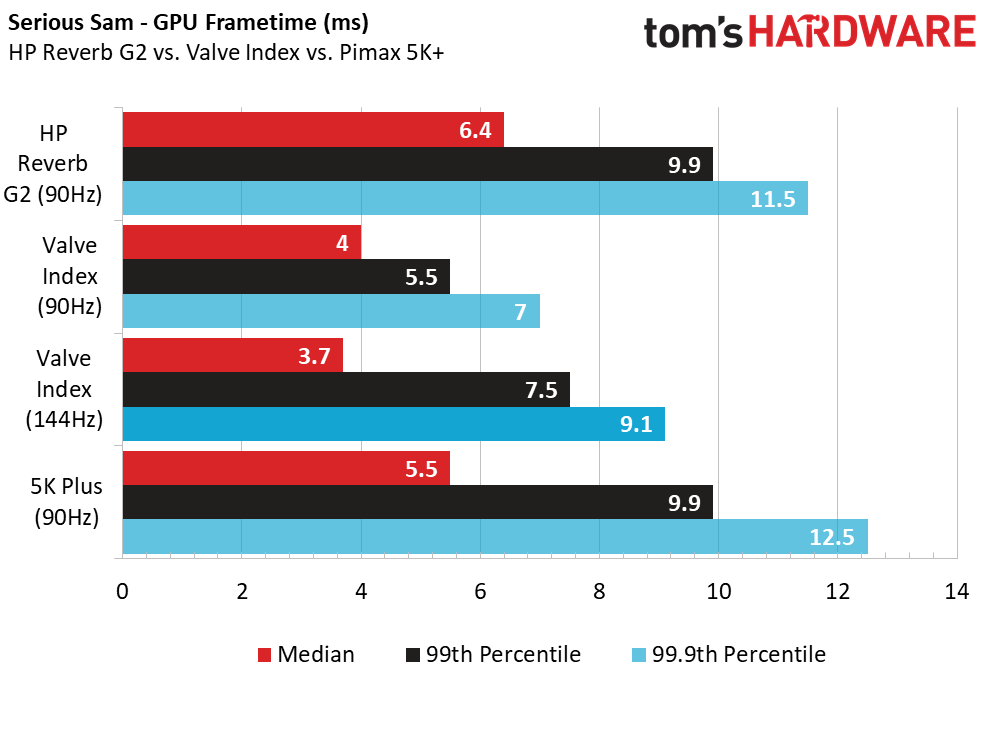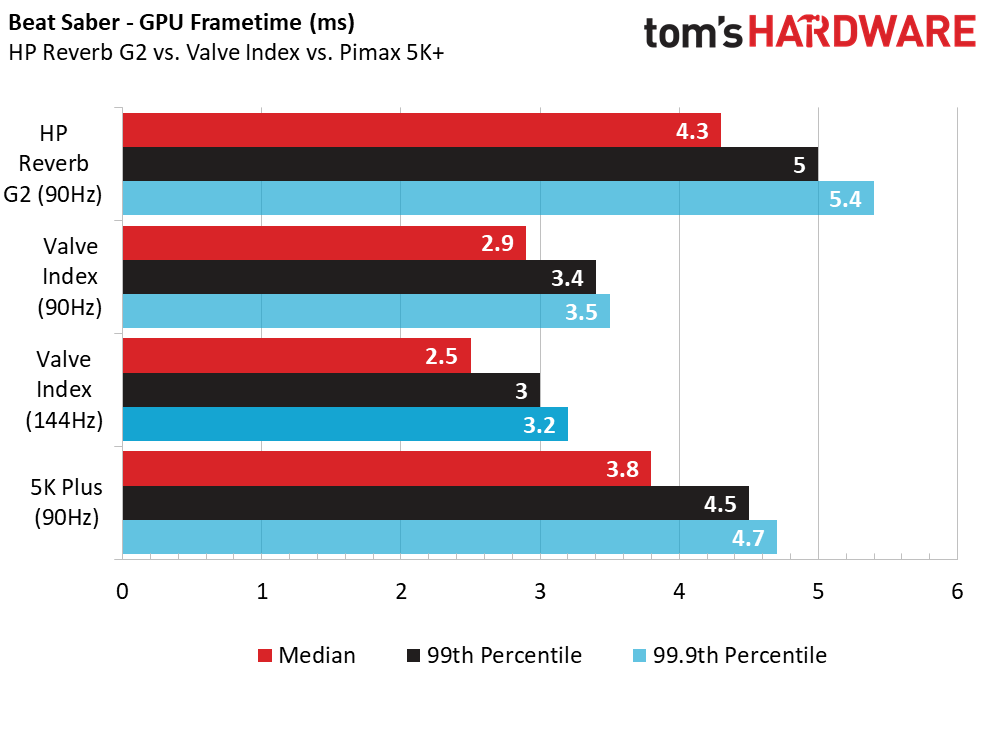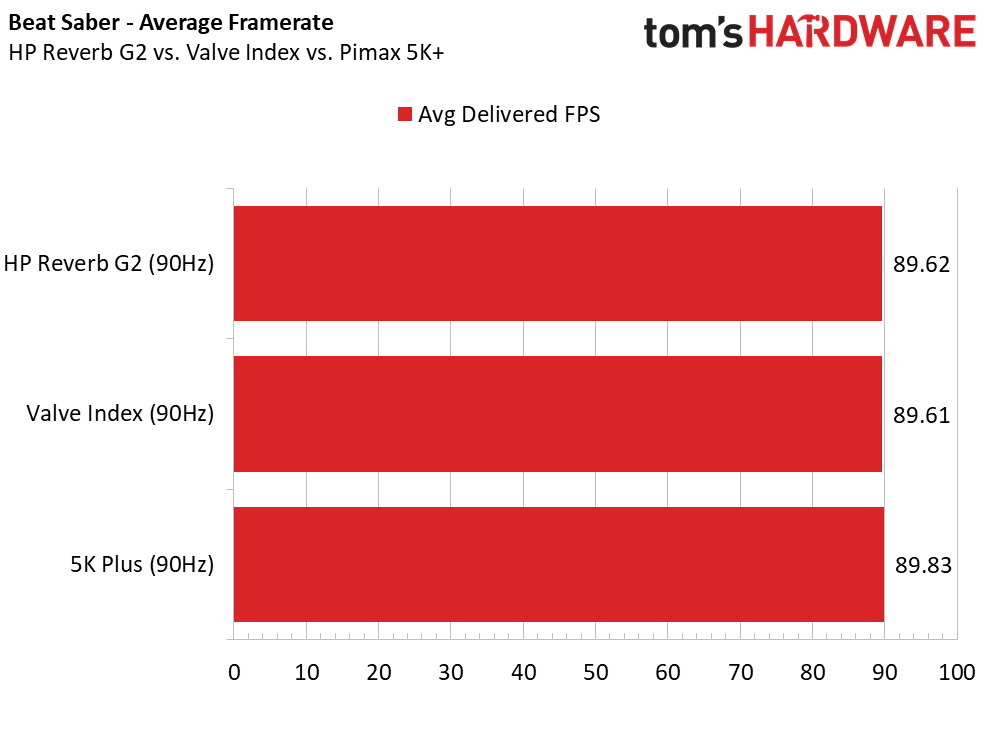Why you can trust Tom's Hardware
As we always do with a new VR headset, we put the Reverb G2 through a series of tests to evaluate the headset's performance. We analyze the graphics and CPU performance in a handful of games. We use Serious Sam VR to test tracking performance under heavy CPU and GPU load, Beat Saber for stress-testing controller tracking accuracy and display persistence. And now we use Half-Life: Alyx for evaluating display clarity.
We also measured the visible field of view with Real O Virtual's Test HMD field of view test.
We performed each test on our standard VR testing system, which includes an Intel Core i7-8700K, 2x8GB of G.Skill Sniper X DDR4-3600 memory, an Asus Prime Z370-A motherboard, and an Nvidia GeForce RTX 2080 Founders Edition graphics card.
Game Settings
| Beat Saber | Mixed Reality display settings: 4320 x 2160 @ 90 Hz |
| Steam VR Render Resolution: 100% - 3184 x 3096 | |
| In-game supersampling: 1x | |
| Serious Sam VR: The Last Hope | Mixed Reality display settings: 4320 x 2160 @ 90 Hz |
| Steam VR Render Resolution: 100% - 3184 x 3096 | |
| in-game settings: supersampling 1x | |
| Half-Life: Alyx | Mixed Reality display settings: 4320 x 2160 @ 90 Hz |
| Steam VR Render Resolution: 100% - 3184 x 3096 | |
| in-game settings: High Fidelity preset |
Tests were performed using version 457.30 of Nvidia's GeForce Drivers.
Field of View Tests
HP's Reverb G2 offers exceptional image clarity, which is a significant factor in delivering an immersive experience. However, the field of view is also a key component – perhaps even more important than resolution. And that’s where the Reverb G2 falls somewhat short.
HP targets a somewhat premium market with the Reverb G2, which means it competes with the likes of Valve's Index and Pimax's 5K and 8K headsets. Those devices offer some of the widest windows in the virtual world of any VR headset, and yet the Reverb G2 produces one of the narrowest fields of view, of any headset we’ve tested.

We ran through the FOV test in Real O Virtual's Test HMD application, and the results were less than spectacular. We observed a vertical FOV of 120-degrees and a horizontal FOV of just 88-degrees in the Reverb G2.
Get Tom's Hardware's best news and in-depth reviews, straight to your inbox.
By contrast, the Valve Index gave us 136-degrees vertical and 110-degrees horizontal, and the Pimax 5K+ offered us a 112-degree virtual and 142-degree horizontal viewport. We even compared the Reverb G2 to the Oculus Rift S and found the Rift S just a touch narrower, at 86-degrees horizontal versus 88-degrees horizontal. What's more, the Rift S gave us a 120-degree vertical view to work with.
The geometry of your face plays a roll in which angles you can see into the headset, so your experience may be different, but it's fair to say that the Reverb G2 is not going to win any awards for the width of its field of view.
Performance Tests
Serious Sam VR: The Last Hope
Serious Sam VR: The Last Hope has been part of the VR test suite since day one. We light this game for benchmarking because it's one of the few VR games that we've tested that stresses the CPU so much. The number of objects on the screen can get intense, and it often pushes the limits of our test system.


Serious Sam VR looks terrific in the Reverb G2, but that high-resolution comes at a significant performance cost. When the action picked up in our Endless Wave run, the frame rate dropped and tracking worsened. We even experienced audio distortion, which seemed to be directly attributed to the performance dip.

Playing this game at high setting on the Reverb G2 would require a potent system. Unless you have an RTX 3080, RTX 3090 or one of AMD's upcoming Radeon 6000 cards, you're probably going to have a bit of trouble with this title.
Half-Life: Alyx
Half-Life: Alyx is an excellent title for testing image quality. Valve filled the game with high-detailed, high-resolution textures, and we've never seen them look this good. The displays in HP's new headset are truly impressive.


Not only is the pixel density over the top, but the RGB displays are very bright and vivid. There's no question that the Reverb G2 offers the best-quality screens of any headset that we've tried to date.

Performance-wise, our GeForce RTX 2080 barely broke a sweat while delivering 887,189,760 pixels per second to the headset's 90 Hz 2160 x 2160 displays.
Beat Saber
Beat Saber is the game that exposed the flaw in HP's headset: the tracking accuracy is atrocious in games like this.


Beat Saber requires that you swing your arms around very rapidly, which the headset has trouble keeping up with. While playing Beat Saber on expert, we often missed the box because the controller wasn't tracking fast enough, and it had a detrimental effect on our score. Our average score for the song we were playing was around 70,000 with the Index, Rift S and Pimax, but often score closer to 55,000 in the Index.

We didn't have any trouble with rendering performance, and we probably could have pushed the resolution in this game a bit further. But it's all for naught if the tracking doesn't work well.
Tracking Accuracy is a Huge Disappointment
When a company sets out to build a successor of a product, it usually makes sense to address the previous version's limitations. When we looked at the original Reverb headset a year and a half ago, we concluded that the Windows Mixed Reality tracking system was one of the product's weakest links.
HP tried to address the tracking problem with the Reverb G2. As with all other Windows Mixed Reality devices, the original headset featured two front-facing cameras that could only capture the area directly in front of the headset. The Reverb G2 includes two additional cameras, which are situated on either side of the visor. The extra cameras allow the headset to keep track of your controllers when you hold them to the sides of your body.

The extra cameras are a welcome addition, but they don't go far enough. Unlike the Oculus Rift S, which includes a downwards facing camera, the Reverb G2 does not have any downward-facing cameras. As a result, if you hold the controllers too close to your chest, the headset often loses track of them for a brief moment. The motion controllers have gyro sensors in them, and Microsoft uses the sensor data to estimate the controller position when the cameras lose sight of them. But that doesn't do you much good if you hold your controllers too close to your body without moving them around.
The tracking system also has trouble keeping up with rapid motion. Beat Saber is one of the most popular VR games on the market, and to play it well, you must swing your controllers around very rapidly. Microsoft's tracking system had a hard time keeping up with my wild flailing arms, and I often noticed one or both virtual hands drifting away from me as I played.
Conclusion
We really hoped to be blown away by HP's new headset. The original Reverb headset was a nice piece of kit that was ultimately held back by Microsoft's Windows Mixed realty tracking cameras' inferior tracking accuracy.

We had really high hopes for the HP Reverb G2. On paper, it's a serious winner. It's super light, very comfortable, has high-quality lenses, incredible displays, and powerful immersive audio. Unfortunately, all of the greatness about the Reverb G2 is overshadowed by one glaring problem: If your movements in the real world don't make your movements in VR, it doesn't matter how good the image quality is.
The last thing we expected with the Reverb G2 was a repeat of past mistakes. But that's exactly what happened. With all the fantastic features of this new headset—and there are several—it's a real shame to have the whole experience marred by wonky controller tracking.
The Reverb G2 is undoubtedly the best consumer-grade headset to get if image quality is of utmost importance. If you need to read text or see fine details, the screen in this headset is about as good as it gets. Racing and flight simulation fans will love the Reverb G2.
But, if tracking accuracy is your biggest priority, you may want to skip this headset. HP stuck with Microsoft's Windows Mixed Reality platform, which relies on headset-mounted cameras for spatial and motion controller tracking. The Reverb G2 includes four cameras, which is a significant improvement for tracking range, but you won't be winning any Beat Saber world records with these motion controllers. The tracking technology just isn't strong enough to keep up when you're moving at a rapid pace.
We love the new ergonomic design of the controllers; it's a shame these didn't hit the market a couple of years ago when the Windows Mixed Reality platform started to pick up steam. With only two tracking cameras, the other Windows MR headsets were even worse for tracking accuracy.
Kevin Carbotte is a contributing writer for Tom's Hardware who primarily covers VR and AR hardware. He has been writing for us for more than four years.
-
colson79 Do you guys have an AMD x570 MB you could test the HP Reverb G2 on? Seems like there is an issue with the usb ports on the X570 not working with the G2. HP acknowledge they are looking into but maybe if it made the news they might work a little harder. Also I haven't had any issues with the controller tracking on my G2. Track works better than on my Rift CV1.Reply -
Kpop4Ever Not sure about that "Real O Virtual's Test HMD application", but your results do not match real-world data collected from owners, which shows consistently that the HFOV on the G2 is actually 98°, not 88°. Additionally, the VFOV on the Index is nowhere near 134°. It's actually 109°, at best.Reply
https://risa2000.github.io/hmdgdb/
https://www.infinite.cz/blog/VR-Field-of-View-measured-explained